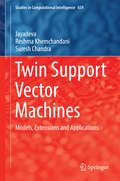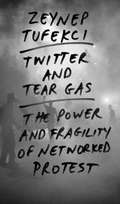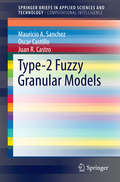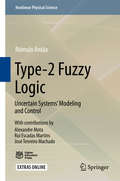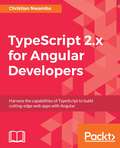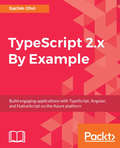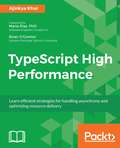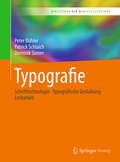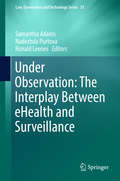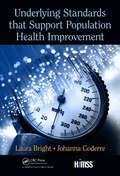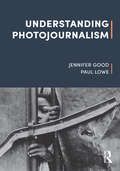- Table View
- List View
Twin Support Vector Machines: Models, Extensions and Applications (Studies in Computational Intelligence #659)
by Jayadeva Reshma Khemchandani Suresh ChandraThis book provides a systematic and focused study of the various aspects of twin support vector machines (TWSVM) and related developments for classification and regression. In addition to presenting most of the basic models of TWSVM and twin support vector regression (TWSVR) available in the literature, it also discusses the important and challenging applications of this new machine learning methodology. A chapter on “Additional Topics” has been included to discuss kernel optimization and support tensor machine topics, which are comparatively new but have great potential in applications. It is primarily written for graduate students and researchers in the area of machine learning and related topics in computer science, mathematics, electrical engineering, management science and finance.
Twitter and Tear Gas: The Power and Fragility of Networked Protest
by Zeynep TufekciA firsthand account and incisive analysis of modern protest, revealing internet-fueled social movements’ greatest strengths and frequent challenges To understand a thwarted Turkish coup, an anti–Wall Street encampment, and a packed Tahrir Square, we must first comprehend the power and the weaknesses of using new technologies to mobilize large numbers of people. An incisive observer, writer, and participant in today’s social movements, Zeynep Tufekci explains in this accessible and compelling book the nuanced trajectories of modern protests—how they form, how they operate differently from past protests, and why they have difficulty persisting in their long-term quests for change. Tufekci speaks from direct experience, combining on-the-ground interviews with insightful analysis. She describes how the internet helped the Zapatista uprisings in Mexico, the necessity of remote Twitter users to organize medical supplies during Arab Spring, the refusal to use bullhorns in the Occupy Movement that started in New York, and the empowering effect of tear gas in Istanbul’s Gezi Park. These details from life inside social movements complete a moving investigation of authority, technology, and culture—and offer essential insights into the future of governance.
Type-2 Fuzzy Granular Models (SpringerBriefs in Applied Sciences and Technology)
by Mauricio A. Sanchez Oscar Castillo Juan R. CastroIn this book, a series of granular algorithms are proposed. A nature inspired granular algorithm based on Newtonian gravitational forces is proposed. A series of methods for the formation of higher-type information granules represented by Interval Type-2 Fuzzy Sets are also shown, via multiple approaches, such as Coefficient of Variation, principle of justifiable granularity, uncertainty-based information concept, and numerical evidence based. And a fuzzy granular application comparison is given as to demonstrate the differences in how uncertainty affects the performance of fuzzy information granules.
Type-2 Fuzzy Logic: Uncertain Systems’ Modeling and Control (Nonlinear Physical Science)
by Rómulo Antão Alexandre Mota Rui Martins José Tenreiro MachadoThis book focuses on a particular domain of Type-2 Fuzzy Logic, related to process modeling and control applications. It deepens readers’understanding of Type-2 Fuzzy Logic with regard to the following three topics: using simpler methods to train a Type-2 Takagi-Sugeno Fuzzy Model; using the principles of Type-2 Fuzzy Logic to reduce the influence of modeling uncertainties on a locally linear n-step ahead predictor; and developing model-based control algorithms according to the Generalized Predictive Control principles using Type-2 Fuzzy Sets. Throughout the book, theory is always complemented with practical applications and readers are invited to take their learning process one step farther and implement their own applications using the algorithms’ source codes (provided). As such, the book offers avaluable referenceguide for allengineers and researchers in the field ofcomputer science who are interested in intelligent systems, rule-based systems and modeling uncertainty.
TypeScript 2 for Angular Developers
by Christian NwambaTypeScript, a superset of JavaScript, is the default language for building Angular applications from Google. TypeScript 2.0 adds optional static types, classes, and modules to JavaScript, to enable great tooling and better structuring of large JavaScript applications. This book will teach you how to leverage the exciting features of TypeScript while working on Angular projects to build scalable, data-intensive web applications. You will begin by setting up and installing TypeScript and then compile it with JavaScript. You will then learn to write simple JavaScript expressions with TypeScript. You will then go through some built in TypeScript types and accessors. Further you will build web components using TypeScript Interfaces and Decorators. You will go through the Angular form module, which will enable you to write predictable typed forms with TypeScript and learn to use typed DOM events. You will also build a single-page application using the Router module. Lastly, you will consume API data with Angular's HTTP Module and handle responses with RxJS observables. At the end of the book, you will go through different testing and debugging techniques. What you will learn Move from loose types to predictable strict types Write self-documented API methods and data structures Understand custom generic types for complex data structures Implement Contract with Interfaces Enhance Dependency Injection in Angular via class constructors Explore TypeScript advanced types Build Interactive web apps with Angular and TypeScript Who This Book Is For This book is for developers who would like to learn to use TypeScript to develop Angular applications. A basic JavaScript knowledge would be beneficial.
TypeScript 2.x By Example: Build Engaging Applications With Typescript, Angular, And Nativescript On The Azure Platform
by Sachin OhriThe TypeScript language, compiler, and open source development toolset brings JavaScript development up to the enterprise level. It allows you to use ES5, ES6, and ES7 JavaScript language features today, including classes, interfaces, generics, modules, and more. Its simple typing syntax enables building large, robust applications using object-oriented techniques and industry-standard design principles. This book aims at teaching you how to get up and running with TypeScript development in the most practical way possible. Taking you through two exciting projects built from scratch, you will learn the basics of TypeScript, before progressing to functions, generics, promises, and callbacks. Then, you’ll get to implement object-oriented programming as well as optimize your applications with effective memory management. You’ll also learn to test and secure your applications, before deploying them. Starting with a basic SPA built using Angular, you will progress on to building, maybe, a Chat application or a cool application. You’ll also learn how to use NativeScript to build a cool mobile application. Each of these applications with be explained in detail, allowing you to grasp the concepts fast. By the end of this book, you will have not only built two amazing projects but you will also have the skills necessary to take your development to the next level. What you will learn Design your first project in Visual Studio Learn about the different data types in TypeScript Create web applications in an object-oriented fashion using TypeScript Build a Trello application using TypeScript's complex features. Explore the tools available in a web application ecosystem to write unit test cases Deploy web applications to cloud and assign resources to the application Who This Book Is For Web developers who would like to learn how to use TypeScript to build amazing applications will benefit from this book. Table of Contents Getting Started with TypeScript Our First Application – Sport News Combinator Sports News Combinator - Adding Features Sports News Combinator - The Final Version Application 2 -- Trello Trello – Adding features Testing Trello Application Build a Chat Application Trello Mobile - Using NativeScript Deploying Sample Trello on the Cloud using Microsoft Azure
TypeScript High Performance
by Ajinkya KherGet lightning speed performance by writing highly efficient code in TypeScript About This Book • Efficiently use Data Structures, Language Constructs, & Handle Asynchrony • Monitor the performance, Code Quality, & Resource Optimizations • Build & Deploy Strategies for Large Scale TypeScript Projects Who This Book Is For This book is for people who have basic knowledge of TypeScript. Experience using JavaScript and familiarity with front end development are the prerequisites. What You Will Learn • Learn about the critical rendering path, and the performance metrics involved along the same • Explore the detailed inner intricacies of a web browser • Build a large scale front end applications and learn the thought process behind architecting such an effort • Understand the challenges of scalability and how TypeScript renders itself to the cause • Learn efficient usage of TypeScript constructs to deliver high performance and avoid common mistakes and pitfalls that can hamper performance • Monitor performance, resolve and detect performance bottlenecks in production, and learn the tools involved In Detail In a world where a tiny decrease in frames per second impacts customer engagement greatly, writing highly scalable code is more of a necessity than a luxury. Using TypeScript you get type checking during development. This gives you the power to write optimized code quickly. This book is also a solid tool to those who're curious to understand the impact of performance in production, and it is of the greatest aid to the proactive developers who like to be cognizant of and avoid the classic pitfalls while coding. The book will starts with explaining the efficient implementation of basic data Structures, data types, and flow control. You will then learn efficient use of advanced language constructs and asynchronous programming. Further, you'll learn different configurations available with TSLint to improve code quality and performance. Next, we'll introduce you to the concepts of profiling and then we deep dive into profiling JS with several tools such as firebug, chrome, fiddler. Finally, you'll learn techniques to build and deploy real world large scale TypeScript applications. Style and approach This book will be a step by step easy to follow guide with focused examples to increase performance of applications and provide optimization techniques.
Typografie: Schrifttechnologie - Typografische Gestaltung - Lesbarkeit (Bibliothek der Mediengestaltung)
by Peter Bühler Patrick Schlaich Dominik SinnerDieser Band der „Bibliothek der Mediengestaltung“ behandelt die Schrifterkennung und Schriftklassifikation, die Lesbarkeit von Schrift und den gestalterischen und technischen Einsatz von Schriften. Außerdem werden die Schrifttechnologie und die Verwaltung von Schriften thematisiert. Für diese Bibliothek wurden die Themen des Kompendiums der Mediengestaltung neu strukturiert, vollständig überarbeitet und in ein handliches Format gebracht. Leitlinien waren hierbei die Anpassung an die Entwicklungen in der Werbe- und Medienbranche sowie die Berücksichtigung der aktuellen Rahmenpläne und Studienordnungen sowie Prüfungsanforderungen der Ausbildungs- und Studiengänge.Die Bände der „Bibliothek der Mediengestaltung“ enthalten zahlreiche praxisorientierte Aufgaben mit Musterlösungen und eignen sich als Lehr- und Arbeitsbücher an Schulen sowie Hochschulen und zum Selbststudium.
Ubiquitous Computing and Ambient Intelligence: 11th International Conference, UCAmI 2017, Philadelphia, PA, USA, November 7–10, 2017, Proceedings (Lecture Notes in Computer Science #10586)
by Sergio F. Ochoa Pritpal Singh José BravoThis book constitutes the refereed conference proceedings of the 11th International Conference on Ubiquitous Computing and Ambient Intelligence, UCAmI 2017, held in Philadelphia, PA, USA in November 2017. The 60 revised full papers and 22 short papers presented were carefully reviewed and selected from 100 submissions. The papers are presented in six tracks and two special sessions. These are Ambient Assisted Living, Human-Computer Interaction, Ambient Intelligence for Health, Internet of Things and Smart Cities, Ad-hoc and Sensor Networks, Sustainability, Socio-Cognitive and Affective Computing, AmI-Systems and Machine Learning.
Ubiquitous Networking: Third International Symposium, UNet 2017, Casablanca, Morocco, May 9-12, 2017, Revised Selected Papers (Lecture Notes in Computer Science #10542)
by Essaid Sabir Ana García Armada Mounir Ghogho Mérouane DebbahThis book constitutes the refereed proceedings of the Third International Symposium on Ubiquitous Networking, UNet 2017, held in Casablanca, Morocco, in May 2017. The 56 full papers presented in this volume were carefully reviewed and selected from 127 submissions. They were organized in topical sections named: context-awareness and autonomy paradigms; mobile edge networking and virtualization; ubiquitous internet of things: emerging technologies and breakthroughs; and enablers, challenges and applications.
The UBTECH Jimu Robots Builder’s Guide: How to Create and Make Them Come to Life
by Mark RollinsCreate robots and other mechanical devices with UBTECH's Jimu Robots kit. This book shows you the high potential for STEM learning with the Jimu Robots, hardware, and software. You'll design a basic and walking creation and bring to life robots of your own. As UBTECH expands their Jimu Robots into the hands of STEM learners and teachers, this book serves as its official companion, providing an introduction to the Jimu Robots wide range of capabilities. In short, The UBTECH Jimu Robots Builder’s Guide will provide inspiration and innovative potential to existing users and those who are into the growing tech/maker trend of Jimu Robots. What You’ll LearnUse all the latest Jimu Robot pieces and kitsApply practical instructions to build creative Jimu Robot modelsImprove STEM education with Jimu RobotsAssemble creations that users can control via smartphone or tablet Who This Book Is ForEducators, makers, tinkerers, and STEM participants
Übungsaufgaben zur Mathematik für Ingenieure: Mit durchgerechneten und erklärten Lösungen
by Thomas RießingerDieses erfolgreiche Übungsbuch erscheint jetzt in der 7. verbesserten Auflage. Der Autor rechnet 159 Übungsaufgaben zur Ingenieurmathematik im Detail vor und erklärt sie. Im Gegensatz zu vielen anderen Übungsbüchern zur Mathematik werden hier nicht nur Ergebnisse oder bestenfalls Lösungsskizzen angegeben. Vielmehr zeigt der Autor, wie man solche Aufgaben vom ersten Ansatz bis zum Ergebnis durchrechnet. Anhand von Beispielen erklärt er die prinzipiellen Methoden, die bei den Aufgaben angewendet werden. Übungsbuch und Lehrbuch "Mathematik für Ingenieure" desselben Autors sind aufeinander abgestimmt.
Übungsbuch zur Analysis: Aufgaben und ausführliche Lösungen (nicht nur) für Studierende der Informatik
by Jens KunathDieses Buch bietet neben einem kompakten Theorieteil eine Vielzahl an Aufgaben und Lösungen, die inhaltlich auf eine Einführung in die Analysis für Informatiker zugeschnitten sind. Die Aufgaben zu den üblichen Themen der eindimensionalen Analysis werden abgerundet durch solche zu den mathematischen Grundkompetenzen, über die jeder Studierende der Informatik verfügen sollte.Die ausführlichen Lösungen ermöglichen dem Leser, Arbeitsmethoden der Analysis verstehen zu lernen und den eigenen Wissensstand selbst zu überprüfen. Somit eignet sich diese Aufgabensammlung hervorragend zur Prüfungsvorbereitung und als Begleitbuch zur Vorlesung und den Übungen.Auch für Studierende anderer Fächer stellt diese Beispielsammlung eine ausgezeichnete Ergänzung zu ihren Lehrbüchern und Skripten dar.
Uncertain Rule-Based Fuzzy Systems: Introduction and New Directions, 2nd Edition
by Jerry M. MendelThe second edition of this textbook provides a fully updated approach to fuzzy sets and systems that can model uncertainty — i.e., “type-2” fuzzy sets and systems. The author demonstrates how to overcome the limitations of classical fuzzy sets and systems, enabling a wide range of applications from time-series forecasting to knowledge mining to control. In this new edition, a bottom-up approach is presented that begins by introducing classical (type-1) fuzzy sets and systems, and then explains how they can be modified to handle uncertainty. The author covers fuzzy rule-based systems – from type-1 to interval type-2 to general type-2 – in one volume. For hands-on experience, the book provides information on accessing MatLab and Java software to complement the content. The book features a full suite of classroom material.
Uncertainty Modeling: Dedicated to Professor Boris Kovalerchuk on his Anniversary (Studies in Computational Intelligence #683)
by Vladik KreinovichThis book commemorates the 65th birthday of Dr. Boris Kovalerchuk, and reflects many of the research areas covered by his work. It focuses on data processing under uncertainty, especially fuzzy data processing, when uncertainty comes from the imprecision of expert opinions. The book includes 17 authoritative contributions by leading experts.
Uncertainty Quantification: An Accelerated Course with Advanced Applications in Computational Engineering (Interdisciplinary Applied Mathematics #47)
by Christian SoizeThis book presents the fundamental notions and advanced mathematical tools in the stochastic modeling of uncertainties and their quantification for large-scale computational models in sciences and engineering. In particular, it focuses in parametric uncertainties, and non-parametric uncertainties with applications from the structural dynamics and vibroacoustics of complex mechanical systems, from micromechanics and multiscale mechanics of heterogeneous materials. Resulting from a course developed by the author, the book begins with a description of the fundamental mathematical tools of probability and statistics that are directly useful for uncertainty quantification. It proceeds with a well carried out description of some basic and advanced methods for constructing stochastic models of uncertainties, paying particular attention to the problem of calibrating and identifying a stochastic model of uncertainty when experimental data is available. This book is intended to be a graduate-level textbook for students as well as professionals interested in the theory, computation, and applications of risk and prediction in science and engineering fields.
Unconventional Computation and Natural Computation: 16th International Conference, UCNC 2017, Fayetteville, AR, USA, June 5-9, 2017, Proceedings (Lecture Notes in Computer Science #10240)
by Matthew J. Patitz Mike StannettThis book constitutes the proceedings of the 16th International Conference on Unconventional Computation and Natural Computation, UCNC 2017, held in Fayetteville, AR, USA in June 2017. The 14 papers presented in this volume were carefully reviewed and selected from 21 submissions. The UCNC series of international conferences is genuinely interdisciplinary and it covers theory as well as experiments and applications. It is concerned with various proposals for computation that go beyond the Turing model, human designed computation inspired by nature, and with the computational nature of processes taking place in nature. Typical, but not exclusive, topics are: hypercomputation; chaos and dynamical systems based computing; granular, fuzzy and rough computing; mechanical computing; cellular, evolutionary, molecular, neural, and quantum computing; membrane computing; amorphous computing, swarm intelligence; artificial immune systems; physics of computation; chemical computation; evolving hardware; the computational nature of self-assembly, developmental processes, bacterial communication, and brain processes.
Unconventional Conflict: A Modeling Perspective (Understanding Complex Systems)
by Dean S. Hartley IIIThis book describes issues in modeling unconventional conflict and suggests a new way to do the modeling. It presents an ontology that describes the unconventional conflict domain, which allows for greater ease in modeling unconventional conflict. Supporting holistic modeling, which means that we can see the entire picture of what needs to be modeled, the ontology allows us to make informed decisions about what to model and what to omit. The unconventional conflict ontology also separates the things we understand best from the things we understand least. This separation means that we can perform verification, validation and accreditation (VV&A) more efficiently and can describe the competence of the model more accurately.However, before this message can be presented in its entirety the supporting body of knowledge has to be explored. For this reason, the book offers chapters that focus on the description of unconventional conflict and the analyses that have been performed, modeling, with a concentration on past efforts at modeling unconventional conflict, the precursors to the ontology, and VV&A. Unconventional conflict is a complex, messy thing. It normally involves multiple actors, with their own conflicting agendas and differing concepts of legitimate actions. This book will present a useful introduction for researchers and professionals within the field.
Under Observation: The Interplay Between eHealth and Surveillance (Law, Governance and Technology Series #35)
by Samantha Adams Nadezhda Purtova Ronald LeenesThe essays in this book clarify the technical, legal, ethical, and social aspects of the interaction between eHealth technologies and surveillance practices. The book starts out by presenting a theoretical framework on eHealth and surveillance, followed by an introduction to the various ideas on eHealth and surveillance explored in the subsequent chapters. Issues addressed in the chapters include privacy and data protection, social acceptance of eHealth, cost-effective and innovative healthcare, as well as the privacy aspects of employee wellness programs using eHealth, the use of mobile health app data by insurance companies, advertising industry and law enforcement, and the ethics of Big Data use in healthcare. A closing chapter draws on the previous content to explore the notion that people are ‘under observation’, bringing together two hitherto unrelated streams of scholarship interested in observation: eHealth and surveillance studies. In short, the book represents a first essential step towards cross-fertilization and offers new insights into the legal, ethical and social significance of being ‘under observation’.
Underlying Standards that Support Population Health Improvement (HIMSS Book Series)
by Laura Bright Johanna GoderreThis book highlights success stories and challenges to implementing health IT standards. The narrative of each chapter demonstrates how standards further interoperable health data exchange, especially in the service of advancing tools to monitor population health. These are critical stories that demonstrate to an international community of health and IT experts how to bring the right stakeholders together and bridge classic divides between software architects and clinical end users, health system decision-makers and standard authors.
Underlying Standards that Support Population Health Improvement (HIMSS Book Series)
by Laura Bright Johanna GoderreThis book highlights success stories and challenges to implementing health IT standards. The narrative of each chapter demonstrates how standards further interoperable health data exchange, especially in the service of advancing tools to monitor population health. These are critical stories that demonstrate to an international community of health and IT experts how to bring the right stakeholders together and bridge classic divides between software architects and clinical end users, health system decision-makers and standard authors.
Understanding and Using Rough Set Based Feature Selection: Concepts, Techniques and Applications
by Muhammad Summair Raza Usman QamarThe book will provide: 1) In depth explanation of rough set theory along with examples of the concepts. 2) Detailed discussion on idea of feature selection. 3) Details of various representative and state of the art feature selection techniques along with algorithmic explanations. 4) Critical review of state of the art rough set based feature selection methods covering strength and weaknesses of each. 5) In depth investigation of various application areas using rough set based feature selection. 6) Complete Library of Rough Set APIs along with complexity analysis and detailed manual of using APIs 7) Program files of various representative Feature Selection algorithms along with explanation of each.The book will be a complete and self-sufficient source both for primary and secondary audience. Starting from basic concepts to state-of-the art implementation, it will be a constant source of help both for practitioners and researchers. Book will provide in-depth explanation of concepts supplemented with working examples to help in practical implementation. As far as practical implementation is concerned, the researcher/practitioner can fully concentrate on his/her own work without any concern towards implementation of basic RST functionality. Providing complexity analysis along with full working programs will further simplify analysis and comparison of algorithms.
Understanding Information: From the Big Bang to Big Data (Advanced Information and Knowledge Processing)
by Alfons Josef SchusterThe motivation of this edited book is to generate an understanding about information, related concepts and the roles they play in the modern, technology permeated world. In order to achieve our goal, we observe how information is understood in domains, such as cosmology, physics, biology, neuroscience, computer science, artificial intelligence, the Internet, big data, information society, or philosophy. Together, these observations form an integrated view so that readers can better understand this exciting building-block of modern-day society. On the surface, information is a relatively straightforward and intuitive concept. Underneath, however, information is a relatively versatile and mysterious entity. For instance, the way a physicist looks at information is not necessarily the same way as that of a biologist, a neuroscientist, a computer scientist, or a philosopher. Actually, when it comes to information, it is common that each field has its domain specific views, motivations, interpretations, definitions, methods, technologies, and challenges. With contributions by authors from a wide range of backgrounds, Understanding Information: From the Big Bang to Big Data will appeal to readers interested in the impact of ‘information’ on modern-day life from a variety of perspectives.
Understanding-Oriented Multimedia Content Analysis (Springer Theses)
by Zechao LiThis book offers a systematic introduction to an understanding-oriented approach to multimedia content analysis. It integrates the visual understanding and learning models into a unified framework, within which the visual understanding guides the model learning while the learned models improve the visual understanding. More specifically, it discusses multimedia content representations and analysis including feature selection, feature extraction, image tagging, user-oriented tag recommendation and understanding-oriented multimedia applications. The book was nominated by the University of Chinese Academy of Sciences and China Computer Federation as an outstanding PhD thesis. By providing the fundamental technologies and state-of-the-art methods, it is a valuable resource for graduate students and researchers working in the field computer vision and machine learning.
Understanding Photojournalism
by Jennifer Good Paul LoweUnderstanding Photojournalism explores the interface between theory and practice at the heart of photojournalism, mapping out the critical questions that photojournalists and picture editors consider in their daily practice and placing these in context. Outlining the history and theory of photojournalism, this textbook explains its historical and contemporary development; who creates, selects and circulates images; and the ethics, aesthetics and politics of the practice. Carefully chosen, international case studies represent a cross section of key photographers, practices and periods within photojournalism, enabling students to understand the central questions and critical concepts. Illustrated with a range of photographs and case material, including interviews with contemporary photojournalists, this book is essential reading for students taking university and college courses on photography within a wide range of disciplines and includes an annotated guide to further reading and a glossary of terms to further expand your studies.
